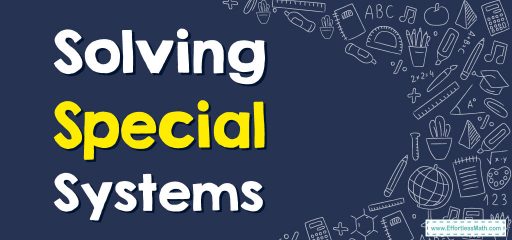How to Solve Special Systems
A special system of \(2\) equations is a system of equations that can be solved using a specific method, such as substitution or elimination. Two common types of special systems are Consistent, dependent systems and Consistent, independent systems.

Related Topics
- How to Solve Systems of Equations Graphically
- How to Solve Systems of Linear Inequalities
- How to Solve Systems of Equations with Substitution
- How to Find the Number of Solutions in a System of Equations
Step-by-step to solve special systems
To solve special systems, follow the step-by-step guide below:
- Consistent, dependent systems: A consistent, dependent system of \(2\) equations is a system of equations that has an infinite number of solutions. This occurs when the two equations are identical or one equation is a multiple of the other. For example, the system of equations \(2x + 3y = 6\) and \(4x + 6y = 12\) has an infinite number of solutions because the second equation is simply twice the first equation. In this case, we can solve the system by solving either equation for one variable and then substituting it into the other equation.
- Consistent, independent systems: A consistent, independent system of \(2\) equations is a system of equations that has one unique solution. This occurs when the two equations are not identical and the system of equations can be solved by elimination or substitution.
Solving Special Systems– Example:
Solve the system of equations
\(\begin{cases}2x+3y=6\\ 4x+6y=12\end{cases}\)
Solution:
Using elimination method: Add the two equations \(\begin{array}{r} &2x + 3y = 6\\ +\!\!\!\!\!\!&4x + 6y = 12 \\ \hline \end{array} \\ \ \ \ \ \ \ 6x + 9y = 18\)
So, we can see that \(x = -3\) then we can substitute this value in one of the equations
\(2(-3) + 3y = 6\)→\(y = 3\)
So, the solution of this system is \(x = -3\) and \(y = 3\)
Related to This Article
More math articles
- How to Use Area Models to Factor Variable Expressions?
- The Ultimate SSAT Upper-Level Math Course (+FREE Worksheets)
- How to Solve Geometric Sequences? (+FREE Worksheet!)
- How to Find the Number of Solutions to a System of Equations by Graphing
- How to Unlock the Secrets: “SIFT Math for Beginners” Solution Manual
- Essential Calculator Tools You Didn’t Know You Needed
- Math Courses Required For A Business Degree
- How to Find Similarity and Ratios? (+FREE Worksheet!)
- How to find Reference Angles from the Calculator
- What is the Type of Tangents to Circles?

















What people say about "How to Solve Special Systems - Effortless Math: We Help Students Learn to LOVE Mathematics"?
No one replied yet.